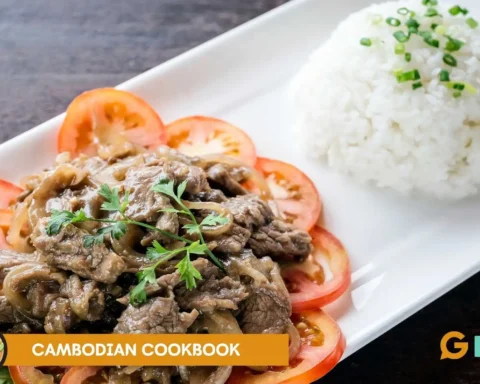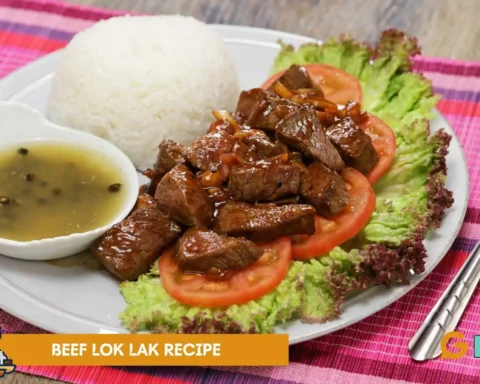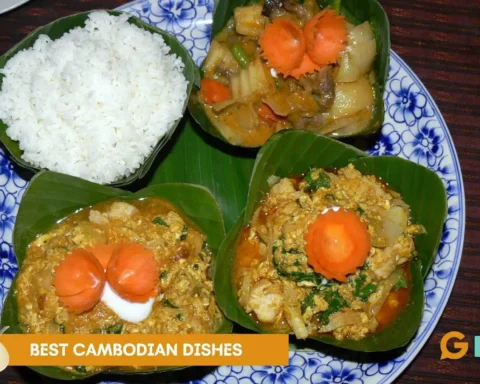Cambodian culinary tradition is a fragrant and richly woven tapestry of ancient heritage, distinctive geography, and cross-cultural infusion. Despite being profoundly ingrained and richly flavoured, it is usually eclipsed by popular Asian cuisines like Thai dishes and Vietnamese cuisine. The Cambodian culinary tradition of the 12th century Angkor Kingdom has developed from the influences of Chinese cuisine, French colonial, and the surrounding Southeast Asian food culture. Underneath the surface is a culinary gold mine of ingredients, methods, and customs. This blog discusses ten interesting things about the rich diversity of Cambodian food culture.
Table of Contents
The Hidden Sophistication of Khmer Cuisine
Khmer food has a rich flavour and sophistication that goes unobserved outside Cambodia. It is dedicated to sour, bitter, sweet, salty, and hot taste harmony. This gastronomic philosophy produces a rich and intense flavour characteristic of the region. The anchor of richness is holy basil, kaffir lime leaves, and lemongrass, which are combined in “Kroeung,” a classic spice paste. Employed as the base for countless traditional dishes in Cambodian food culture, this fragrant mixture conveys flavour, history, and spirituality to each dish.
The Influence of Geography: Tonle Sap and Riverine Delicacies
Tonle Sap, Southeast Asia’s largest freshwater body, is more than a body of water- it’s the pulse of Cambodian cuisine. The lake and the river systems that feed it are chock-full of fresh fish, a key ingredient in Cambodian dishes such as fish amok and river fish curry. Those recipes frequently include banana leaves, coconut milk, and ingredients like banana flowers to create robust yet delicate flavours. Dishes like Canh Chua, a sour soup made from tamarind and lime juice, show how geography affects Cambodian culinary identity.
Beyond Amok: Real Cambodian Food Culture
Though Amok Trey is conventionally advertised as Cambodia’s national dish, it only scratches the surface of Cambodian food culture. French-seasoned beef lok lak and bai sach crook and killed pork breakfast fare with white rice demonstrate the daily diversity of Khmer cuisine. Sticky rice, sweet potatoes, and ground rice are even used in innovative measures by Cambodian food culture, both in entrées and desserts, to provide satisfaction, thrift, and harmony with local tradition to every meal.
The Khmer Rouge and the Forgotten Gourmet History
The deplorable regime of the Khmer Rouge was cataclysmically destructive to Cambodian society and its gourmet past. Family heritage, age-old ingredients, and preparation methods were suppressed or forgotten when citizens were resettled to work camps and family customs shattered. Fortunately, interest in traditional fare and Royal Cambodian Home Cuisine has increased. A new breed of restaurateurs and chefs are now bringing back forgotten flavours and presenting them to contemporary diners, reclaiming culinary heritage and mending a nation’s hurt.

Culinary Diplomacy Through Food
Over the past few years, Cambodia has embraced food utilization through cultural and culinary diplomacy. With global food expos and several diasporas, Khmer cuisine is increasingly presented in the international limelight. Cambodian diaspora-owned restaurants are introducing signature foods such as beef skewers and vegetable stir-fry to the world stage. Food has emerged as a powerful bridge, opening avenues for communication, cultural exchange, and a greater understanding of Cambodian food culture through online media.
Street Food and Covered Markets
Cambodia’s street food is a doorway to the daily world. The street vendors have everything from noodle soups and rice noodles to dipping sauces full of flavour. Visiting Cambodia’s markets is like embarking on a sensory journey, where each bite listens to a story. The covered markets are filled with exotic ingredients like ants on beef, bamboo shoots, and brightly coloured tropical fruits, all giving a taste of Cambodia’s diversity and imagination.
Herbal Healing and Depth of Flavour
Herbs aren’t merely used as flavourings in Cambodian food culture but are also prized for their medicinal properties. Spices like lemongrass, star anise, and spring onions are liberally utilized in soups and marinades. Bean sprouts, raw vegetables, or green onions are used to garner most dishes, so each tastes great and suits you. Blurring the lines between health and taste illustrates how food is inextricably tied to the cycles of life and wellness in Cambodian homes.
The Flexibility of Noodles and Rice
Rice isn’t just a basic ingredient in Cambodian cuisine; it’s the base on which the whole meal is constructed. Plain rice in a bowl can be paired with pungent stews or made into desserts like condensed milk and sticky rice. Noodles are equally versatile, as seen in the variations of Khmer noodles, egg noodle soups, and stir-fried versions made better with fish paste, green beans, and oyster sauce. The mixture of starches with topping seasonings and sauces shows the diversity and creativity of Cambodian cuisine.
New Twists in Cambodian Restaurants
Cambodian cooking nowadays is succeeding in combining tradition and international fashion. Chefs are experimenting with new versions of the old using global ingredients and techniques but remaining true to authentic Khmer flavour. Breakfast varies, ranging from rich rice porridges to vibrant fruit platters and fruit shakes in hues of colour. Such a mix signals that Cambodia embraces change but still honours its gastronomic heritage.
The Future of Cambodian Food Culture
Cambodian food culture is undergoing a resplendent revival. Chefs and instructors are working to document and save Khmer food, with bush food flora, culinary skills, and sustainability at the forefront. Each ingredient’s nutritional value and cultural background, from Cambodian salad application of banana blossom to green peppercorn spiced pepper crabs, are highlighted. While the culinary world catches up, Cambodian food is poised to tell its tale, deep in heritage, spicy in taste, and full of promise for what lies ahead.
With its rich cultural heritage, resilience, and constantly evolving creativity, Cambodian cuisine is more than sustenance. It’s a forceful declaration of history, identity, and community. With increasing international attention, Cambodian food is ready to join its rightful place at the table of the world’s great cuisines.
Conclusion
Cambodian food culture is more than a roll call of tasty foods. The country’s rich culinary tradition is a living history of Cambodia, its geography, and its people. From Kroeung’s understated elegance to street stalls’ social camaraderie, each dish is redolent with history. As global palates open up and Cambodia finds its place on the world food map, it’s apparent that Khmer food is set to become one of the world’s favourite cuisines. If you haven’t tried it, consider this your invitation to dig in.

FAQs
What is the traditional food of Cambodia?
Cambodian traditional dishes are Amok (steamed curry fish), Samlor Korkor (vegetable soup), and Bai Sach Chrouk (pork and rice) with herbs and fermented foods for seasoning.
What is the national dish of Cambodia?
The national dish of Cambodia is Fish Amok, a creamy curry prepared with freshwater fish, coconut milk, and kroeung (Cambodian spice paste), steamed in banana leaves.
What is traditional food culture?
Traditional food culture is the dietetic tradition, foods, and eating habits passed down from generation to generation and are usually linked to local culture, seasonality, and community values.









